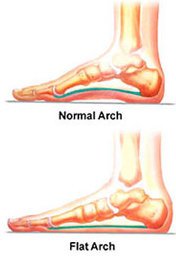
Flat foot is one of the commonest problems among children and adults. People with flat feet tend to have a medial arch lower than normal or completely touching the ground.
Children have two types of flat foot. If the arch appears when the child is not walking and flattens out when he is, it usually indicates a flexible or correctable flat foot. It usually causes little problem. If the inside arch appears flat whether the child is walking or resting, it is usually a rigid or non-correctable flat foot, which is a cause for concern and requires assessment and treatment early in childhood.
Why children have flat foot
Majority of the flat foot cases in children are developmental, meaning they are a normal occurrence from birth and improve as the child grows. Children who have flat feet into their teens and have symptoms like pain on running may require treatment.
Other causes
- Tarsal coalitions: A condition where foot joints grow together, restricting or prohibiting the movement of that joint.
- Genetic factors: You are more prone to flat foot if your parents or somebody else in your family have it.
- Those with neurological or muscular disease such as cerebral palsy, muscular dystrophy are more prone to the condition.
In adults
If you have developed flat foot late in life, this is a cause for concern. This problem is more common in middle-aged women and is usually due to the weakness of the tibialis posterior muscle on the inside of the ankle, which is the main muscle supporting the arch. The muscle weakness is aggravated by weight gain, hormonal changes, pregnancy and diabetes. Sometimes it is brought on by an injury to the foot. You need to consult an orthopaedic surgeon for advice and assessment.
If you are concerned about your feet, call today.
0800 473 776
